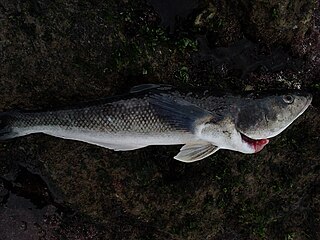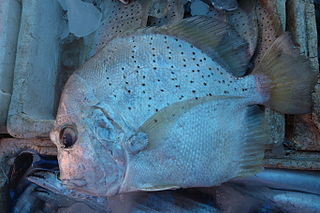
The flagtails are a family (Kuhliidae) of perciform fish of the Indo-Pacific area. The family consists of about 12 species in one genus, Kuhlia. Most are euryhaline and often found in brackish water, but the genus also includes species restricted to marine or fresh water.

Acropomatidae is a family of ray-finned fish in the order Acropomatiformes, commonly known as lanternbellies. Acropoma species are notable for having light-emitting organs along their undersides. They are found in all temperate and tropical oceans, usually at depths of several hundred meters. There are about 32 species in as many as 9 genera, although some authorities recognise fewer genera than Fishbase does.
The spikey bass is a species of ray-finned fish in the family Latidae, the lates perches. It is endemic to coastal waters off Western Australia, where it inhabits areas with soft substrates. It is the only species in the monotypic genus Hypopterus.

Pentacerotidae or armourheads are a small family of ray-finned fishes in the order Acropomatiformes. They are native to the Indian Ocean, western and central Pacific, and southwestern Atlantic. They are generally found at rocky reefs below normal scuba diving depths, although several species occur in low densities at shallower depths.

Cryptacanthodes is a genus of marine ray-finned fishes belonging to the monogeneric family Cryptacanthodidae, commonly referred to as wrymouths. Three of the four species are found in the Pacific Ocean with one species native to the western Atlantic Ocean where they are benthic fishes, tunneling through soft substrates. It is currently the only known genus in its family.

The Patagonian blennie, also known as the rock cod, is a species of marine ray-finned fish, belonging to the monotypic family Eleginopidae and monotypic genus Eleginops. It is found in coastal and estuarine habitats around southernmost South America.

Pseudotriacanthus is a monospecific genus of marine ray-finned fish belonging to the family Triacanthidae, the triplespines or tripodfishes. The only species in this genus is Pseudotriacanthus strigilifer, the longspined tripodfish. This taxon is found in the Indo-West Pacific region.

Pleurogrammus is a genus of ray-finned fishes belonging to the family Hexagrammidae, the greenlings, known as Atka mackerels. These fishes are found in the northwestern Pacific Ocean.

The slender fusilier is a species of marine ray-finned fish, a fusilier belonging to the family Caesionidae. It is native to tropical reefs in the Indian Ocean and the western Pacific Ocean, it is of minor importance to local commercial fisheries. This species is the only known member of its genus.

Hemicaranx is a genus of ray-finned fish from the family Carangidae, the jacks, pompanos, scads and trevallies, found in the Atlantic and Pacific oceans.

Pseudocaranx is a genus of ray-finned fishes from the family Carangidae, the jacks, trevallies, scads, and pompanos. They occur in the western Atlantic Ocean and the Indo-Pacific.
The scalemouth jobfish, also known as the scalemouth snapper, is a species of marine ray-finned fish, a snapper belonging to the family Lutjanidae. It is native to the Pacific Ocean. This species is the only known member of its genus.

Drepane punctata, the butterfish, concertinafish, jetto, peppercorn, sickle-fish, silver moonfish, spotted batfish, spotted sicklefish, sicklefish or spotted spadefish, is a species of ray-finned fish belonging to the family Drepaneidae, the sicklefishes. This fish is found in the Indo-Pacific.

Otolithes ruber, commonly known as the tigertooth croaker, silver teraglin, wiretooth, snapper kob, snapper salmon, Yankee whiting or Yankee salmon is a species of marine ray-finned fish belonging to the family Sciaenidae, the drums and croakers. This species is found in the Indo-Pacific region.

The skipjack trevally or sand trevally is a species of ray-finned fish in the family Carangidae, the jacks, trevallies, pompanos, and scads. It is found in the eastern Indian Ocean around Australia.

Pomadasys argenteus, the silver grunt, silver javelin, grunter bream, small-spotted grunter-bream, small-spotted javelin fish, trumpeter or white-finned javelin fish, is a species of marine ray-finned fish, a grunt from the family Haemulidae. This species has a wide Indo-Pacific distribution. It is the type species of the genus Pomadasys.
Parascolopsis townsendi, the scaly dwarf monocle bream, is a species of marine ray-finned fish in the family Nemipteridae, the threadfin breams. It is found in the western Indian Ocean.

Triacanthus nieuhofii, the silver tripodfish, is a species of marine ray-finned fish belonging to the family Triacanthidae, the triplespines or tripodfishes. This species is found in the Indo-West Pacific region.

Grammatonotus laysanus, the purple groppo, is a species of marine ray-finned fish belonging to the family Callanthiidae, the groppos and splendid perches. This fish is found in the Pacific Ocean.

The doublewhip threadfin bream is a species of marine ray-finned fish belonging to the family Nemipteridae, the threadfin breams. This species is found in the Indo-West Pacific region.




















